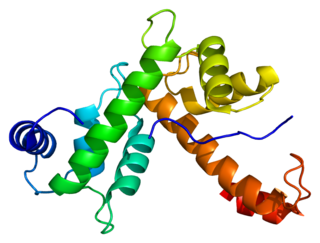
Programmed cell death protein 6 is a protein that in humans is encoded by the PDCD6 gene.

Endophilin-A1 is a protein that in humans is encoded by the SH3GL2 gene.

Charged multivesicular body protein 2b is a protein that in humans is encoded by the CHMP2B gene. It forms part of one of the endosomal sorting complexes required for transport (ESCRT) - specifically ESCRT-III - which are a series of complexes involved in cell membrane remodelling. CHMP2B forms long chains that spiral around the neck of a budding vesicle. Along with the other components of ESCRT-III, CHMP2B constricts the neck of the vesicle just before it is cleaved away from the membrane.

Annexin A7 is a protein that in humans is encoded by the ANXA7 gene.

Charged multivesicular body protein 3 is a protein that in humans is encoded by the VPS24 gene.

Vacuolar protein sorting-associated protein 4A is a protein that in humans is encoded by the VPS4A gene.

Vacuolar protein sorting-associated protein 4B is a protein that in humans is encoded by the VPS4B gene.

Endophilin-A2 is a protein that in humans is encoded by the SH3GL1 gene.

Alpha-1,3/1,6-mannosyltransferase ALG2 is an enzyme that is encoded by the ALG2 gene. Mutations in the human gene are associated with congenital defects in glycosylation The protein encoded by the ALG2 gene belongs to two classes of enzymes: GDP-Man:Man1GlcNAc2-PP-dolichol alpha-1,3-mannosyltransferase and GDP-Man:Man2GlcNAc2-PP-dolichol alpha-1,6-mannosyltransferase.

Charged multivesicular body protein 4b is a protein that in humans is encoded by the CHMP4B gene.

Charged multivesicular body protein 4a is a protein that in humans is encoded by the CHMP4A gene.

Charged multivesicular body protein 5 is a protein that in humans is encoded by the CHMP5 gene.

Charged multivesicular body protein 6 is a protein that in humans is encoded by the CHMP6 gene.

Charged multivesicular body protein 2a is a protein that in humans is encoded by the CHMP2A gene.
It is a reference gene.

Charged multivesicular body protein 1a is a protein that in humans is encoded by the CHMP1A gene.

Charged multivesicular body protein 1b is a protein that in humans is encoded by the CHMP1B gene.

Peflin is a protein that in humans is encoded by the PEF1 gene.

Charged multivesicular body protein 4c is a protein that in humans is encoded by the CHMP4C gene.

Vacuolar protein-sorting-associated protein 25 is a protein that in humans is encoded by the VPS25 gene.
The endosomal sorting complexes required for transport (ESCRT) machinery is made up of cytosolic protein complexes, known as ESCRT-0, ESCRT-I, ESCRT-II, and ESCRT-III. Together with a number of accessory proteins, these ESCRT complexes enable a unique mode of membrane remodeling that results in membranes bending/budding away from the cytoplasm. These ESCRT components have been isolated and studied in a number of organisms including yeast and humans. A eukaryotic signature protein, the machinery is found in all eukaryotes and some archaea.


























